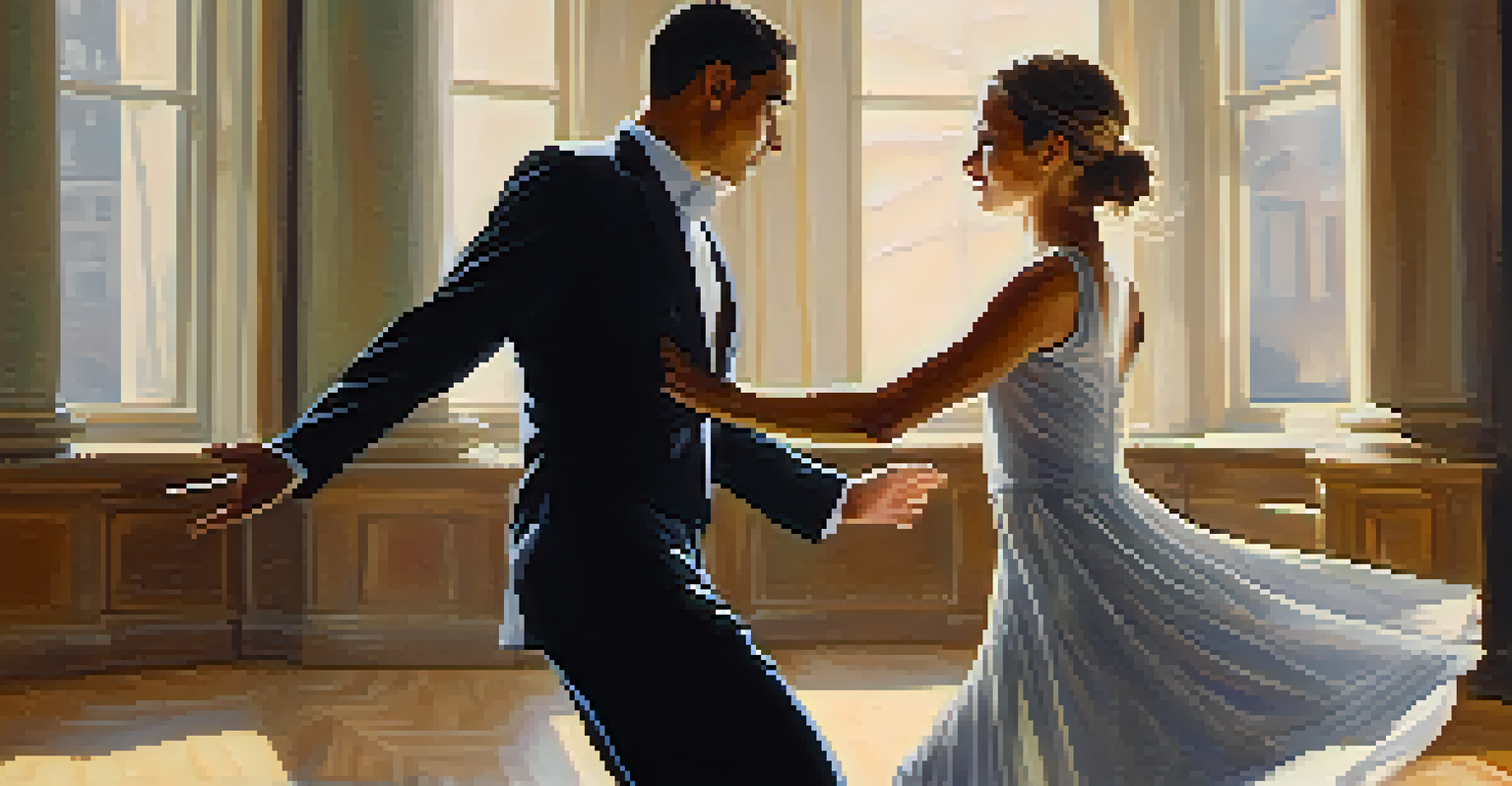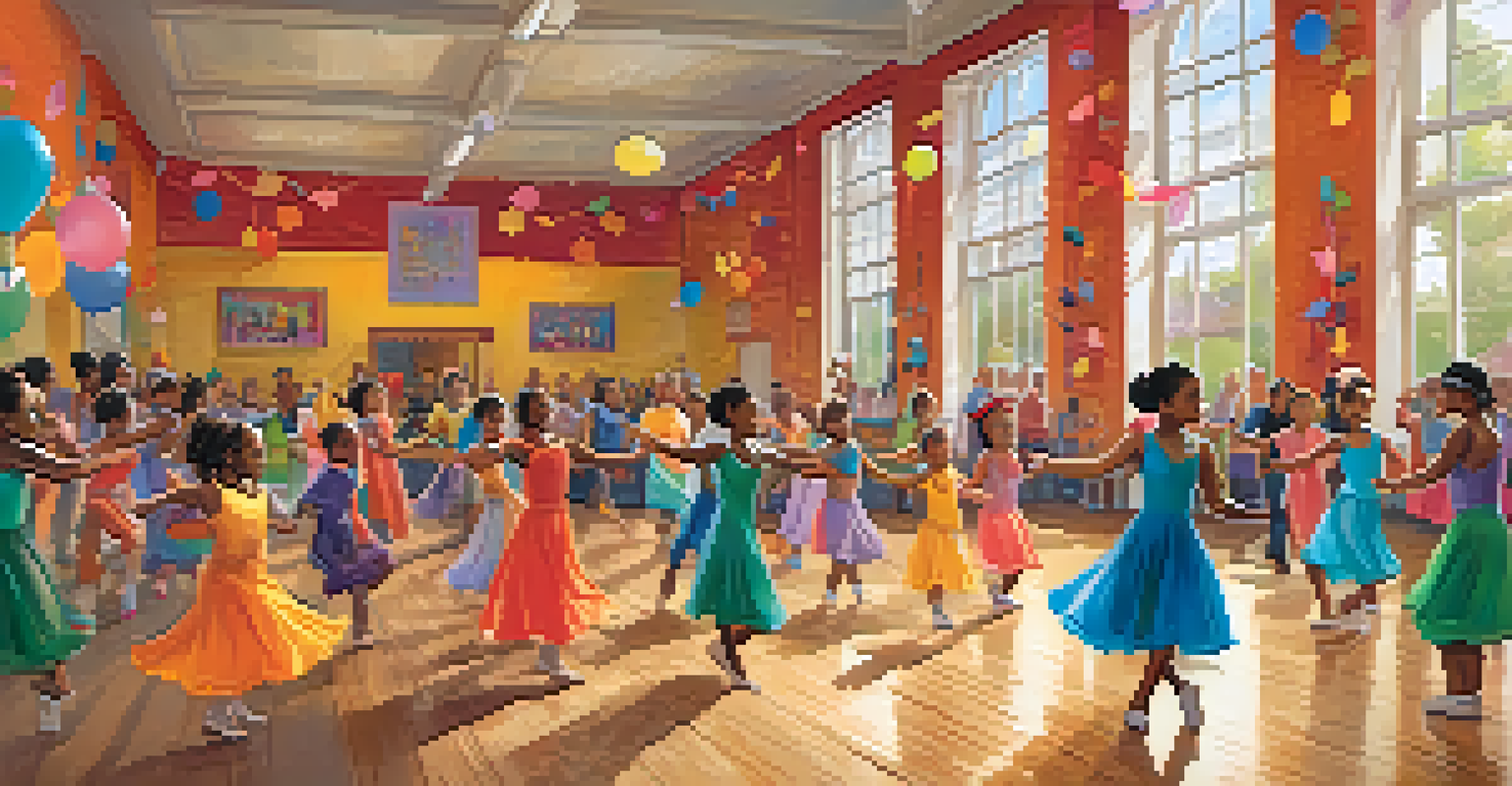Dance as a Medium for Increasing Emotional Intelligence

Understanding Emotional Intelligence in Simple Terms
Emotional intelligence, often referred to as EQ, is the ability to recognize, understand, and manage our own emotions while also empathizing with others. It’s a crucial skill for personal and professional success, influencing how we interact with the world. Think of it as the emotional toolkit that helps us navigate life's ups and downs effectively.
Dance is the hidden language of the soul.
Unlike IQ, which measures cognitive abilities, EQ is all about feelings and relationships. People with high emotional intelligence tend to have better communication skills, stronger relationships, and an easier time managing stress. They can read the room, pick up on social cues, and respond appropriately, making them more adaptable in various situations.
Dance, as an expressive art form, can significantly enhance our emotional intelligence. By engaging with our own emotions and those of others through movement, we can develop a deeper understanding of ourselves and foster more meaningful connections with those around us.
Dance as a Form of Emotional Expression
Dance allows individuals to express their emotions in a physical and creative way. It serves as a release, helping to channel feelings that might be difficult to articulate with words. When we dance, we engage our bodies in a way that can reveal our inner emotional state, whether it’s joy, sadness, or frustration.

For instance, think about how a dancer interprets a piece of music. The movements convey emotions that resonate with the audience, creating a shared experience. This process not only helps the dancer communicate their feelings but also encourages viewers to connect with their own emotions, fostering empathy and understanding.
Dance Enhances Emotional Intelligence
Engaging in dance helps individuals develop emotional intelligence by fostering expression, empathy, and self-regulation.
By practicing dance, we learn to identify and express our emotions more freely. This awareness is a significant step toward enhancing our emotional intelligence, as it encourages us to become more in tune with ourselves and the feelings of those around us.
Building Empathy Through Partner Dancing
Partner dancing, such as salsa or ballroom, offers a unique opportunity to cultivate empathy. When dancing with a partner, you must be attuned to their movements, intentions, and emotional expressions. This connection requires active listening and responsiveness, both vital components of emotional intelligence.
Emotional intelligence is the ability to use emotion to enhance your thinking.
Imagine leading a partner in dance; it’s not just about your movements but also about how you can guide and support them. You learn to anticipate their needs and adjust your actions accordingly, which mirrors the dynamics of effective communication in real-life relationships.
Through partner dancing, we practice stepping outside ourselves and considering someone else's perspective, a key aspect of empathy. This practice can extend beyond the dance floor, helping us in everyday interactions, whether at work or in personal relationships.
Improving Self-Regulation with Dance
Self-regulation is the ability to manage one’s emotions and behaviors, especially in challenging situations. Dance offers an engaging platform to practice this skill, as it often requires discipline, focus, and control. When we dance, we learn to channel our energy and emotions into our movements, rather than letting them take over.
Consider a dancer who is feeling anxious before a performance. Instead of allowing that anxiety to overwhelm them, they can use dance to express it, transforming nervous energy into powerful movement. This act of regulation not only improves performance but also enhances overall emotional resilience.
Empathy Grows Through Partner Dancing
Partner dancing requires attunement to a partner's movements and emotions, enhancing empathy and communication skills.
The more we practice self-regulation through dance, the more adept we become at handling our emotions in daily life. This skill translates into better decision-making, less impulsivity, and a greater sense of calm in stressful situations.
The Role of Mindfulness in Dance
Mindfulness, the practice of being present and fully engaging with the moment, is integral to both dance and emotional intelligence. When we dance mindfully, we become aware of our emotions, thoughts, and bodily sensations, allowing us to process and understand them better. This heightened awareness is essential for improving emotional intelligence.
For example, during a dance class, focusing on each movement can help us connect with our feelings as we express them through our bodies. This connection can lead to greater self-awareness, helping us discern what we’re experiencing emotionally at any given moment.
Practicing mindfulness in dance not only enhances our performance but also deepens our emotional understanding. As we learn to be more present with ourselves, we can extend that presence to our interactions with others, improving our overall emotional intelligence.
Dance as a Tool for Building Community
Participating in dance classes or community dance events fosters a sense of belonging and connection. These shared experiences can strengthen social bonds and enhance emotional intelligence within a community. When people come together to dance, they often form supportive networks that contribute to personal growth.
Think about a local dance group where individuals of various backgrounds unite to learn and grow together. This communal experience helps participants cultivate empathy, as they learn about each other’s stories through movement. It’s a beautiful reminder that we all share similar emotions, regardless of our differences.
Resilience Built Through Dance Challenges
Facing challenges in dance cultivates resilience, teaching individuals to adapt and grow from setbacks.
Being part of a dance community encourages emotional growth and awareness. As relationships deepen and trust builds, individuals often feel more comfortable expressing their emotions, which further enhances their emotional intelligence.
Cultivating Resilience Through Dance Experiences
Dance often involves facing challenges, whether mastering a new step or performing in front of an audience. These experiences teach resilience, a crucial component of emotional intelligence. When we stumble or make mistakes, dance encourages us to keep going, reinforcing the idea that setbacks are part of the learning process.
Consider a dancer who forgets their routine during a performance. Instead of panicking, they learn to adapt, improvising their way through the rest of the song. This adaptability not only showcases resilience but also builds confidence in handling unexpected situations.

By embracing challenges in dance, we cultivate a mindset that views obstacles as opportunities for growth. This resilience can empower us in all areas of life, enhancing our emotional intelligence as we learn to navigate difficulties with grace and composure.
Conclusion: Dance as a Pathway to Emotional Growth
In summary, dance serves as a powerful medium for enhancing emotional intelligence. Through expression, empathy, self-regulation, and community, dance provides a rich landscape for personal and emotional growth. It invites us to explore our feelings and connect deeply with ourselves and others.
As we engage in dance, we are not just moving our bodies; we are also developing skills that can positively impact our emotional lives. From building resilience to practicing mindfulness, the benefits of dance extend far beyond the dance floor.
Ultimately, embracing dance as a tool for emotional development can lead to more fulfilling relationships and a deeper understanding of ourselves. So, whether you’re an experienced dancer or just starting, remember that every step you take is an opportunity for emotional growth.